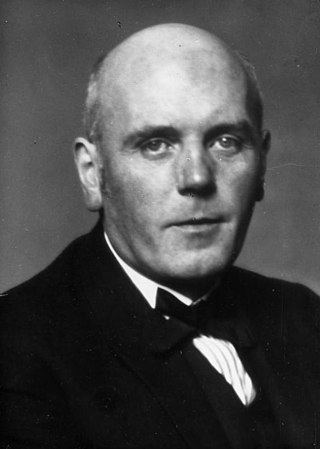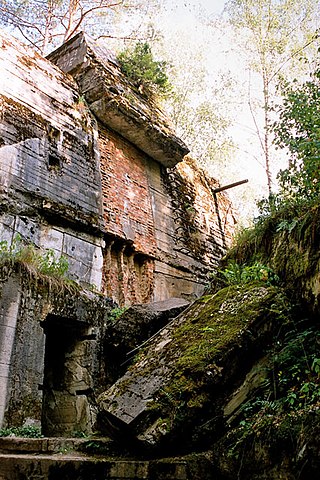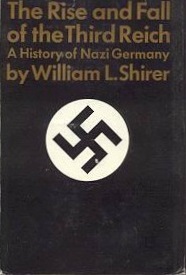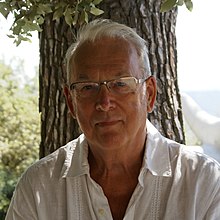
Berthold Konrad Hermann Albert Speer was a German architect who served as the Minister of Armaments and War Production in Nazi Germany during most of World War II. A close ally of Adolf Hitler, he was convicted at the Nuremberg trials and sentenced to 20 years in prison.

Walther Funk was a German economist and Nazi official who served as Reich Minister for Economic Affairs (1938–1945) and president of Reichsbank (1939–1945). During his incumbency, he oversaw the mobilization of German economy for rearmament and arrangement of forced labor in concentration camps. After the war he was tried and convicted as a major war criminal by the International Military Tribunal at Nuremberg. Sentenced to life in prison, he remained incarcerated until he was released on health grounds in 1957. He died three years later.

Inside the Third Reich is a memoir written by Albert Speer, the Nazi Minister of Armaments from 1942 to 1945, serving as Adolf Hitler's main architect before this period. It is considered to be one of the most detailed descriptions of the inner workings and leadership of Nazi Germany but is controversial because of Speer's lack of discussion of Nazi atrocities and questions regarding his degree of awareness or involvement with them. First published in 1969, it appeared in English translation in 1970.

Paul Ludwig Troost was a German architect. A favourite master builder of Adolf Hitler from 1930, his Neoclassical designs for the Führerbau and the Haus der Kunst in Munich influenced the style of Nazi architecture.

The Reich Chancellery was the traditional name of the office of the Chancellor of Germany in the period of the German Reich from 1878 to 1945. The Chancellery's seat, selected and prepared since 1875, was the former city palace of Prince Antoni Radziwiłł (1775–1833) on Wilhelmstraße in Berlin. Both the palace and a new Reich Chancellery building were seriously damaged during World War II and subsequently demolished.

Hans Heinrich Lammers was a German jurist and prominent Nazi politician. From 1933 until 1945 he served as Chief of the Reich Chancellery under Adolf Hitler. During the 1948–1949 Ministries Trial, Lammers was found guilty of war crimes and crimes against humanity and sentenced to 20 years' imprisonment.

Sir Richard John Evans is a British historian of 19th- and 20th-century Europe with a focus on Germany. He is the author of eighteen books, including his three-volume The Third Reich Trilogy (2003–2008). Evans was Regius Professor of History at the University of Cambridge from 2008 until his retirement in 2014, and President of Cambridge's Wolfson College from 2010 to 2017. He has been Provost of Gresham College in London since 2014. Evans was appointed Knight Bachelor for services to scholarship in the 2012 Birthday Honours.

Adolf Hitler was an Austrian-born German politician who was the dictator of Germany from 1933 until his suicide in 1945. He rose to power as the leader of the Nazi Party, becoming the chancellor in 1933 and then taking the title of Führer und Reichskanzler in 1934. During his dictatorship, he initiated World War II in Europe by invading Poland on 1 September 1939. He was closely involved in military operations throughout the war and was central to the perpetration of the Holocaust: the genocide of about six million Jews and millions of other victims.

This bibliography of Adolf Hitler is an English only non-fiction bibliography. There are thousands of books written about Hitler; therefore, this is not an all-inclusive list. The list has been segregated into groups to make the list more manageable.
A census in May 1939, six years into the Nazi era and after the annexation of mostly Catholic Austria and mostly Catholic Czechoslovakia into Germany, indicates that 54% of the population considered itself Protestant, 41% considered itself Catholic, 3.5% self-identified as Gottgläubig, and 1.5% as "atheist". Protestants were over-represented in the Nazi Party's membership and electorate, and Catholics were under-represented.

"Hitler's Table Talk" is the title given to a series of World War II monologues delivered by Adolf Hitler, which were transcribed from 1941 to 1944. Hitler's remarks were recorded by Heinrich Heim, Henry Picker and Martin Bormann and later published by different editors under different titles in four languages.

The Cathedral of Light or Lichtdom was a main aesthetic feature of the Nazi Party rallies in Nuremberg from 1934 to 1938. Designed by architect Albert Speer, it consisted of 152 anti-aircraft searchlights, at intervals of 12 metres, aimed skyward to create a series of vertical bars surrounding the audience. The Cathedral of Light was documented in the Nazi propaganda film Festliches Nürnberg, released in 1937.

Like many other Western nations at the time, Germany suffered the economic effects of the Great Depression with unemployment soaring around the Wall Street Crash of 1929. When Adolf Hitler became Chancellor of Germany in 1933, he introduced policies aimed at improving the economy. The changes included privatization of state industries, tariffs on imports, and an attempt to achieve autarky. Weekly earnings increased by 19% in real terms from 1933 to 1939, but this was largely due to employees working longer hours, while the hourly wage rates remained close to the lowest levels reached during the Great Depression. In addition, reduced foreign trade meant rationing of consumer goods like poultry, fruit, and clothing for many Germans.

Franz Xaver Dorsch was a German civil engineer who became the chief engineer of the Organisation Todt (OT), a civil and military engineering group in Nazi Germany that was responsible for a huge range of engineering projects at home and in the territories occupied by the Germans during the Second World War. He played a leading role in many of the Third Reich's biggest engineering projects, including the construction of the Siegfried Line (Westwall), the Atlantic Wall and numerous other fortifications in Germany and occupied Europe. Following the war, he founded the Dorsch Consult consulting engineering company in Wiesbaden.
Dick Geary was a British historian. He studied at City of Leicester Boys' Grammar School and King's College, Cambridge, graduating with a degree in History in 1967.

This is a list of books about Nazi Germany, the state that existed in Germany during the period from 1933 to 1945, when its government was controlled by Adolf Hitler and his National Socialist German Workers' Party. It also includes some important works on the development of Nazi imperial ideology, totalitarianism, German society during the era, the formation of anti-Semitic racial policies, the post-war ramifications of Nazism, along with various conceptual interpretations of the Third Reich.

This is a bibliographyof works on World War II.

Nazi architecture is the architecture promoted by Adolf Hitler and the Nazi regime from 1933 until its fall in 1945, connected with urban planning in Nazi Germany. It is characterized by three forms: a stripped neoclassicism, typified by the designs of Albert Speer; a vernacular style that drew inspiration from traditional rural architecture, especially alpine; and a utilitarian style followed for major infrastructure projects and industrial or military complexes. Nazi ideology took a pluralist attitude to architecture; however, Hitler himself believed that form follows function and wrote against "stupid imitations of the past".

Speer: Hitler's Architect is a biography of Albert Speer written in 2015 by Martin Kitchen.
This is a Bibliography of World War II battles and campaigns in Europe, North Africa and the Middle East. It aims to include the major theaters, campaigns and battles of the European theater of World War II. It is part of Wikipedia's larger effort to document the Bibliography of World War II. Its counterpart for the Asia-Pacific theater is the Bibliography of World War II battles and campaigns in East Asia, South East Asia and the Pacific.

















